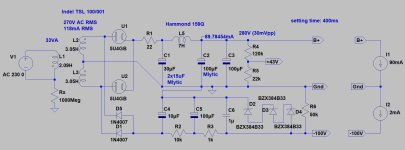Starting a new amplifier (6SJ7/6V6 PP) with toroids (power and output).

Unfortunately there is no bias windings provided, I could just leave as this and go cathode bias but I prefer fixed (or mixed) bias.
The center of the toroid PT is molded, I can't add a winding.. or have to remove the molding with great care..
Here are two ways to add a negative supply:

And this one from J Stewart:

From what I understand from the J. Stewart negative bias supply is that R111 develops a voltage, right?
Any advice is welcome, thanks
Unfortunately there is no bias windings provided, I could just leave as this and go cathode bias but I prefer fixed (or mixed) bias.
The center of the toroid PT is molded, I can't add a winding.. or have to remove the molding with great care..
Here are two ways to add a negative supply:
And this one from J Stewart:
From what I understand from the J. Stewart negative bias supply is that R111 develops a voltage, right?
Any advice is welcome, thanks
În the second schematic the resistor will disipatie a lot of power, so I recommend something dimirat with the first Ideea. Or, if the necessary curent is low, you can multiply the filament voltage.
Why not a reverse 6.3 volt filament tranny running off one of the filament supplies? 6.3VAC -> 115VAC, reverse diode, cap. Surely there's room under there for a little 500mA tranny...?
It is rarely, if ever, a good idea to add a significant resistance to the CT of the PT. The CT is the Mother Ground of the PS and if you add resistance there you seperate all the other components of the amp that are looking for a direct connection to that ground point. When you put resistance there you are also beginning to create a non-CT type of PT, and will see the output voltages change accordingly. Would you place a 100R resistor under the PS filter caps in any other amp? That is what this arrangement creates.Any advice is welcome, thanks
The top schematic of Post # 1 will charge to the peak voltage X 1/2 of the transformer secondary voltage.
Example, a 250-0-250 secondary will give - 354V.
You have to have a resistor across C15 in order to drop voltage across p2 5k, and R17 2k.
For a bias of only 66V, you can use larger values than p2 5k and R17 2k, so the resistor across C15 can be fairly large too, then all 3 resistors will not dissipate lots of power from 354V.
We need a low current negative bias supply for the output tube grids;
we do not need the higher current that a push pull driver tube cathode pair needs.
Example, a 250-0-250 secondary will give - 354V.
You have to have a resistor across C15 in order to drop voltage across p2 5k, and R17 2k.
For a bias of only 66V, you can use larger values than p2 5k and R17 2k, so the resistor across C15 can be fairly large too, then all 3 resistors will not dissipate lots of power from 354V.
We need a low current negative bias supply for the output tube grids;
we do not need the higher current that a push pull driver tube cathode pair needs.
Thank you all.
So schematic 1 or from euro21 will be choosen.
Not really inclined to buy transformers again, for bias only.. ( I don't have some on the shelf)
Two mono's in one chassis.
Added thin old wood, not perfect but DIY after all.

Tube rectifiers (5Y3) this time, I'll add a standby switch (DPDT on the 5V winding).
XLR > Sowter 8920 > 2 x 6SJ7 > 2 x 6V6
Input transformers could be omitted but in case of input tube failure (short), quite rare but..
So schematic 1 or from euro21 will be choosen.
Not really inclined to buy transformers again, for bias only.. ( I don't have some on the shelf)
Two mono's in one chassis.
Added thin old wood, not perfect but DIY after all.
Tube rectifiers (5Y3) this time, I'll add a standby switch (DPDT on the 5V winding).
XLR > Sowter 8920 > 2 x 6SJ7 > 2 x 6V6
Input transformers could be omitted but in case of input tube failure (short), quite rare but..
The second schematic is called "back bias" - really not much difference from cathode bias.
I've used a capacitor (0.27 @ 2KV) in series with the diode in the first circuit - minimal heat generated. Requires a resistor to ground as DC return, which sets the DC voltage.
I've used a capacitor (0.27 @ 2KV) in series with the diode in the first circuit - minimal heat generated. Requires a resistor to ground as DC return, which sets the DC voltage.
- Home
- Amplifiers
- Tubes / Valves
- mixed/fixed bias without low voltage winding available
